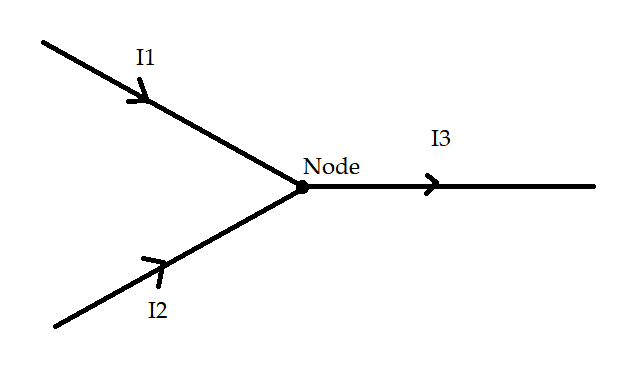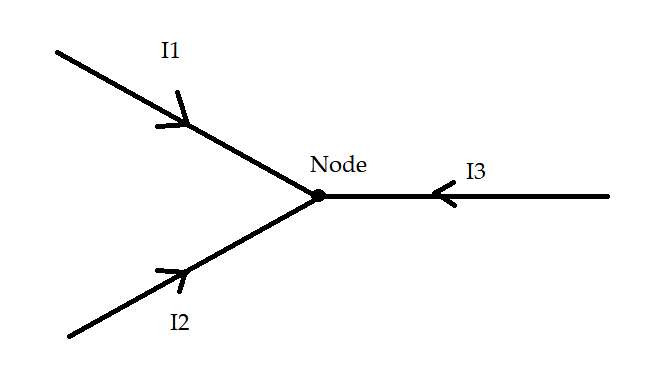
State Kirchoff’s current law and also give the sign convention for current.
Answer
141k+ views
Hint: We will start with discussing and understanding Kirchoff's law. Kirchoofs’s law is considered as fundamental laws that have a variety of applications in electrical engineering and electrical sciences. Kirchoff’s law is categorized and given by two laws, Kirchoff’s current law and Kirchoff's voltage laws.
Complete step by step solution:
Kirchoff's current law is also known as junction rule and it is also known as Kirchoff’s first law. The principle of this law is to preserve or conserve the electric charges. Kirchhoff's first or junction rule states that the amount of electric current flowing through any node in the electric circuits is equal to the sum of all the currents flowing out of it. Hence the nodal analysis can be done by using ohms’ law.

From the above diagram, it can be seen that the currents in the three wires can be given by

From the above diagram, it can be seen that the currents in the three wires can be given by
Hence from the above examples, the sign conventions of Kirchhoff's first law can be given.
The sign convention for Kirchoff's first law can be given that the current entering in the circuit is considered as positive as a result in the first diagram the currents
In the second figure the currents
Note: The second Kirchoff's law is Kirchoff's law of voltage states that the voltage at any node which is made up of two or more junctions of wire in an electrically closed circuit is equal to zero. Hence in a circuit, the total amount of energy that is gained is equal to the energy lost per unit charge.
Complete step by step solution:
Kirchoff's current law is also known as junction rule and it is also known as Kirchoff’s first law. The principle of this law is to preserve or conserve the electric charges. Kirchhoff's first or junction rule states that the amount of electric current flowing through any node in the electric circuits is equal to the sum of all the currents flowing out of it. Hence the nodal analysis can be done by using ohms’ law.

From the above diagram, it can be seen that the currents in the three wires can be given by

From the above diagram, it can be seen that the currents in the three wires can be given by
Hence from the above examples, the sign conventions of Kirchhoff's first law can be given.
The sign convention for Kirchoff's first law can be given that the current entering in the circuit is considered as positive as a result in the first diagram the currents
In the second figure the currents
Note: The second Kirchoff's law is Kirchoff's law of voltage states that the voltage at any node which is made up of two or more junctions of wire in an electrically closed circuit is equal to zero. Hence in a circuit, the total amount of energy that is gained is equal to the energy lost per unit charge.
Recently Updated Pages
Young's Double Slit Experiment Step by Step Derivation

Difference Between Circuit Switching and Packet Switching

Difference Between Mass and Weight

JEE Main Participating Colleges 2024 - A Complete List of Top Colleges

JEE Main Maths Paper Pattern 2025 – Marking, Sections & Tips

Sign up for JEE Main 2025 Live Classes - Vedantu

Trending doubts
JEE Main 2025 Session 2: Application Form (Out), Exam Dates (Released), Eligibility, & More

JEE Main Exam Marking Scheme: Detailed Breakdown of Marks and Negative Marking

JEE Main 2025: Derivation of Equation of Trajectory in Physics

Electric Field Due to Uniformly Charged Ring for JEE Main 2025 - Formula and Derivation

Learn About Angle Of Deviation In Prism: JEE Main Physics 2025

Electric field due to uniformly charged sphere class 12 physics JEE_Main

Other Pages
JEE Advanced Marks vs Ranks 2025: Understanding Category-wise Qualifying Marks and Previous Year Cut-offs

JEE Advanced Weightage 2025 Chapter-Wise for Physics, Maths and Chemistry

Degree of Dissociation and Its Formula With Solved Example for JEE

JEE Main 2025: Conversion of Galvanometer Into Ammeter And Voltmeter in Physics

Dual Nature of Radiation and Matter Class 12 Notes: CBSE Physics Chapter 11

Formula for number of images formed by two plane mirrors class 12 physics JEE_Main




